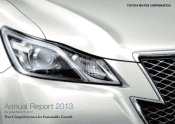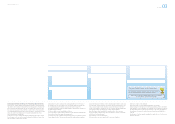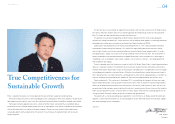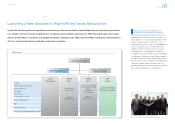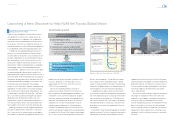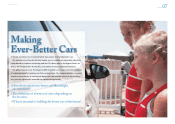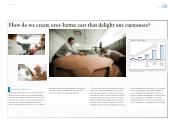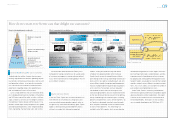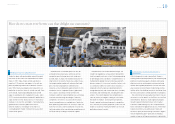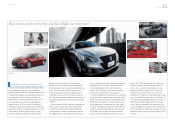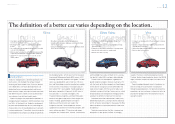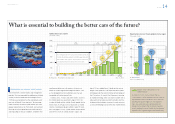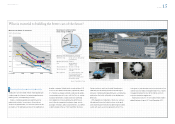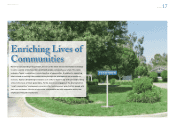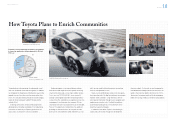Toyota 2013 Annual Report Download - page 9
Download and view the complete annual report
Please find page 9 of the 2013 Toyota annual report below. You can navigate through the pages in the report by either clicking on the pages listed below, or by using the keyword search tool below to find specific information within the annual report.
Source: Toyota Motor Corp.
Toyota Global Vision President’s Message Launching a New Structure Special Feature Review of Operations
Consolidated Performance
Highlights
Management and
Corporate Information Investor InformationFinancial Section
Page 09
NextPrev
ContentsSearchPrint
ANNUAL REPORT 2013
Consistently delivering better cars to customers
Toyota divides the vehicles it makes into four zones:
exciting, high performance vehicles; appealing yet prac-
tical vehicles; commercial and heavy-duty vehicles; and
next-generation vehicles. In our pursuit of ever-better
cars, we listen to our customers to understand their
expectations regarding design, driving performance,
ride, and equipment in each of these zones.
Just as a road determines the cars that will be driven
on it, collaboration between the members of marketing
and R&D teams around the world, as well as staff from
Japan, enables us to make cars that delight customers
the world over. Toyota’s design and R&D bases in nine
locations outside Japan are key components of its global-
ized and localized operations, which integrate develop-
ment, engineering, manufacturing, sales, and services.
The Toyota New Global Architecture (TNGA) is our
framework for making ever-better cars for a wide variety
of customers and regions in smarter and more effi cient
ways, with the ultimate aim of creating products that stir
our customers’ emotions.
Smarter and more effi cient
In line with TNGA, Toyota aims to make ever-better cars
more effi ciently by simultaneously cutting basic costs
and substantially improving product appeal—which at
fi rst glance may seem to be contradictory goals. Toyota
applies a distinct planning and development process
with each car model, fi rst fi nalizing the projected
toward optimizing processes in each region—for exam-
ple, matching interior cabins, exterior designs, and driv-
ing performance to the preferences of our customers.
By grouping and unifying optimal driving positions and
hip-point heights, we are able to share common cockpit
modules and parts across different car models and plat-
forms. This, in turn, allows us to cut both the number of
part variations and engineering man-hours.
Under TNGA, Toyota is increasing standardization
while enhancing basic performance and product appeal
above and beyond customer expectations. We expect
TNGA to result in lower basic costs and contribute to
enhanced profi tability. Toyota plans to start unveiling
new car models developed under TNGA from 2015.
medium- to long-term product lineup and release
schedule, then grouping models within the lineup.
Toyota intends to raise the competitiveness of basic
parts relating to ride, turning, and braking to world-class
levels, and it is now able to standardize parts and units
across different models through grouped development
that puts multiple models through the planning process
at the same time. For example, we have separately
standardized the parts and units for compact, mid-
sized, and large platforms (chassis) respectively. Based
on the new vehicle architecture, we aim for full optimiza-
tion by standardizing even more basic parts, including
platforms and powertrains, across vehicle segments. So
far, Toyota has developed three front-wheel-drive plat-
forms and plans to develop several car models based
on each of these platforms. This streamlining has
resulted in extra R&D capacity, which we are directing
s
in
i
g
hi
h
h
h
g
h
-q
-
-
-
-
ua
a
l
l
li
ty
b
b
b
b
as
ic
c
c
p
ar
r
r
ts
ananan
a
a
d
d
d
sh
s
s
sh
sh
ar
r
ar
ar
r
in
in
in
g
g
g
ththth
t
t
emem
m
em
m
a
a
a
crcrcr
r
r
os
os
os
s
s
s
di
ffer
en
e
e
e
t
ve
v
v
v
v
hi
cl
c
c
e
se
e
e
e
gm
gm
gm
en
ts
s
s
a
a
a
rs
rs
rs
r
w
it
t
it
t
it
h
h
h
un
n
n
n
n
iq
iq
iq
ue
e
e
e
c
ha
a
ha
a
ha
ra
ct
t
ct
ct
e
e
er
is
is
titi
ti
cs
dududu
u
u
e
e
e
to
o
o
to
to
r
r
r
eg
eg
eg
io
io
io
io
nanana
a
a
l
l
l
op
op
p
op
titi
t
ti
t
mi
mi
mi
zazaza
za
z
ti
ti
ti
onon
on
on
an
n
n
n
d
di
d
d
d
d
ff
er
r
r
e
e
en
ti
at
a
a
a
i
o
n
n
n
Product
lineup
Architecture
Modules and parts
Medium- to long-term
plans
Toyota’s car manufacturing
design concepts
Grouped planning &
development
Compatible systems and
parts families
Parts developed for medium-
to long-term scenarios
U
s
d
Ca
C
Ca
d
d
d
Improving basic ride,
turning, and braking
performance
Appealing cars
Zone A Zone B Zone C Zone D
Focus on interests and sensibilities
(particularly for sports cars)
High-volume cars for individuals and
the general public
Special-purpose vehicles, taxis,
commercial vehicles
Next-generation vehicles
(Environment-friendly cars,
new concept cars)
Customer expectations
• Individualistic designs
• Excitement and inspiration
• Superior driving performance
• Emotional engagement and
sensory appeal
• Appealing designs
• High basic performance
• Ease of use
• Price and affordability
• Durability
• Ease of use
• Price and affordability
• New concepts
• New technologies
• Environment-friendly/energy-
saving features
Common items: quality, safety, environmental performance
Shift to zone B in the future
Representation of vehicle volume
LFA CROWN HIACE WELCAB PRIUS TOYOTA i-ROAD
What is required of ever-better carsHow to standardize parts and units
INSIGHT Our engineers always keep customer expectations fi rmly in mind
New concept cars
How do we create ever-better cars that delight our customers?
Making Ever-Better Cars [3 of 10] Enriching Lives of Communities Stable Base of Business
HIA
H
H
CE
E
WEL
E
E
CAB
A
A
CRO
R
WN
W
W
W

